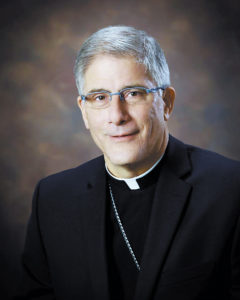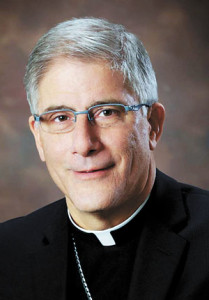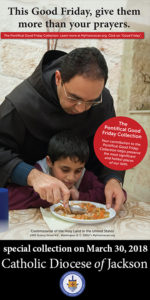
Bishop Joseph R. Kopacz
By Bishop Joseph Kopacz
A few weeks ago, I participated in four listening/dialogue sessions around the Diocese of Jackson in response to the current crisis in the aftermath of the Pennsylvania grand jury report and the Cardinal Theodore McCarrick scandal. These sessions occurred over four consecutive days, October 4-7, in Tupelo, Cleveland, Madison and Natchez with a combined total of nearly 200 concerned Catholic parishioners in attendance. Sister Dorothy Heiderscheit, who served in the Diocese of Jackson on two different occasions spanning three decades, facilitated the four sessions. She is now the Director of the Southdown Institute outside of Toronto, Canada. All in attendance were given the opportunity to respond to the following three questions.
1. What feelings, emotions, concerns surface for you at this time?
2. How do you sustain yourself as a faith filled person during this time?
3. What will help you continue to move forward?
Following the model of the 17 Envisioning Listening Sessions from two and a half years ago all participants were able to reflect quietly at table, engage in conversation, and then share the fruit of their table discussions with all in attendance. I believe that the participants, although not as numerous as the 1,100 who attended the Envisioning Listening Sessions, well represented the Diocese of Jackson as a whole. The questions gave everyone the opportunity to air in a heartfelt and respectful way the depth of their emotions, share their faith, their love for the Church, and to ask pointed questions about our diocesan structures, our polices and protocols, our support and compassion for victims of sexual abuse, our response to allegations of abuse today, our relationship with civil authorities, the voice of women and their consequential roles at all levels of diocesan life, the authentic independence of our diocesan lay boards and of those who investigate allegations, the selection of candidates for the seminary, as well as seminary formation, transparency and accountability, the current state of safe environments in our parishes, schools and ministries, and how the bishops will respond at their November meeting in Baltimore, especially regarding transparent protocols for their own accountability.
The sessions lasted between one-and-a-half and two hours, and Sister Dorothy observed, “many in attendance expressed their gratitude for having an opportunity to share concerns and frustrations and ideas with the bishop, and to have their questions answered with honesty and openness.”
I shared with the attendees that their emotions and their voices that cry out for repentance, justice and reconciliation from the center of the Catholic Church to the margins, arise from the heart of God. We all have a deep sense that abuse by an ordained cleric far surpasses the sexual abuse of a teacher, coach, trainer, neighbor or an extended family member, etc., In these instances, as brutal as it is, a victim often can find comfort, support and hope in their families. Clergy sexual abuse is more on par with the abuse by a parent because in both instances the safety and security of home, in this case one’s spiritual home, the Church, is destroyed. It’s an outrage because it can shatter one’s relationship with Jesus Christ and his saving love. Indeed, the participants expressed their visceral emotions of anger at the abusers, especially predators, and the mis-management and cover up of some in the hierarchy. Other feelings were shame, profound sorrow, confusion and uncertainty about the future of the Church, fear, overwhelming sadness, embarrassment about being Catholic, worry, compassion for the victims and families, and for all faithful clergy.
Many of the participants were midlife and older. There was a shared sentiment that this is a heavy burden for cradle Catholics whose trust in the Church and her leadership has been the foundation for their lives. Why a preponderance of attendees from the second half of life? On the one hand, many young people are not stakeholders in the Church and this is not a priority. Another observed, on a positive note, that younger families who are involved in the Church have experienced first-hand since 2002 that our ministries and programs maintain a high level of safety for their children and young people, fostering confidence in the Church’s commitment to protect within safe environments. It was reinforced for me during these four sessions that it is not inconsequential to discuss appropriately the Church’s efforts since 2002, not in a smug or matter-of-fact way, but in the context of transparency and accountability. Older Catholic who have not directly experienced safe environment protocols in recent decades were appreciative to know the positive effects of our safe environment standards, the active relationship with the District Attorney in each county, the independent and timely manner of investigating and processing allegations when they come to light, and most of all, our outreach and active concern for all victims of sexual abuse in the Church.
The deeper levels of repentance, conversion, healing and hope are always a work in progress and we know beyond a shadow of a doubt that the Lord Jesus is speaking at this time through many prophets in the Church and society, most of whom are not ordained. Because the Church is a 2,000-year-old world-wide organization, change can be painfully slow. Paradoxically, because the Church is a world-wide body, at times change can happen at an accelerated pace. What evidence is there for this? In the 16-and-a-half years since the Dallas Charter our commitment to effective protocols for safe environments have transformed the landscape and culture of the Catholic Church in the United States. The entire Body of Christ, laity and ordained, has been turning the wheel of transparency and accountability since 2002.
It occurred to me last Sunday at Southaven Christ the King during the celebration of Confirmation that the vast majority of the 74 Confimandi who celebrated the gift of the Holy Spirit were born in 2002 or later. They have known the blessings of effective safe environment standards in the Church’s ministries and programs. I share this reflection as an example of what can happen when laity and ordained work together for the good of the entire Body of Christ, the Church, especially on behalf of our children and young people. I have hope and confidence, not naively, that wherever the rot of clericalism, and the resistance to conversion festers in the Church, the light of Jesus Christ will shine in this darkness, transforming the Body of Christ. All who love the Lord Jesus and the Church are called to pray and work together to this end.



